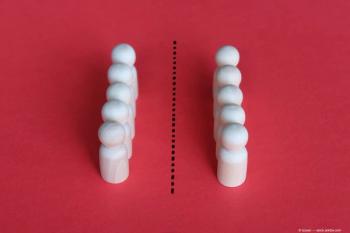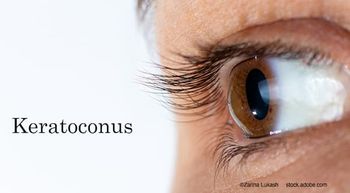
Fixed dose of ROCK/NET inhibitor, latanoprost meets endpoint
A fixed-dose combination containing an investigational rho kinase/norepinephrine transporter inhibitor and latanoprost 0.005% achieved its primary endpoint, showing potential as a high-efficacy, IOP-lowering therapy in a phase IIb trial.
TAKE HOME:
A fixed-dose combination containing an investigational rho kinase/norepinephrine transporter inhibitor and latanoprost 0.005% achieved its primary endpoint, showing potential as a high-efficacy, IOP-lowering therapy in a phase IIb trial.
Dr. Lewis
By Cheryl Guttman Krader; Reviewed by Richard L. Lewis, MD
Sacramento, CA-A once-daily eye drop product that combines a novel triple-action eye drop with a prostaglandin analogue has the potential to be a highly efficacious
The fixed-dose combination (PG324 0.02%; Roclatan, Aerie Pharmaceuticals) of an investigational rho kinase/norepinephrine transporter (
“The ROCK/NET inhibitor represents a new class of IOP-lowering medication that works via a unique mechanism of action,” said Richard L. Lewis, MD, a
“It increases conventional outflow through the trabecular meshwork, reduces aqueous fluid production secondary to NET inhibition, and has been recently shown to lower episcleral venous pressure,” Dr. Lewis said. “With the addition of latanoprost that increases uveoscleral outflow, PG324 theoretically provides a quadruple mechanism of action for lowering IOP.”
Based on the positive results, a phase III trial of the fixed-dose combination is being planned.
NEXT: Treatment arms
Treatment arms
The phase IIb study also included a fourth treatment arm in which patients received a version of the fixed-dose combination product formulated with a lower concentration of the ROCK/NET inhibitor, 0.01%, plus latanoprost 0.005%.
A total of 297 patients with ocular hypertension or open-angle glaucoma were randomly assigned equally into the four treatment groups. Patients were instructed to use their assigned medication once daily in the evening and had IOP measurements at 8 a.m., 10 a.m., and 4 p.m. at baseline (Day 1) and on Day 8, 15, and 29.
Mean diurnal IOP at Day 29 was assessed as the primary endpoint. Results showed a statistically significant difference favoring the efficacy of PG324 0.02% versus both the ROCK/NET inhibitor alone and latanoprost alone.
PG324 0.02% was also consistently significantly superior to the individual components in a secondary outcome analysis of mean IOP at each post-treatment timepoint. Compared with the latanoprost group, mean IOP in eyes treated with PG324 0.02% was 1.6 to 3.2 mm Hg lower across all assessments, and the differences in mean IOP comparing the PG324 0.02% and AR-13324 0.02% groups ranged between 1.7 and 3.4 mm Hg.
NEXT: Other analyses
“If the preliminary study data are confirmed in the new clinical trial in regard to efficacy and safety, the fixed-dose combination product could become an important addition to our therapeutic armamentarium with potential roles as both a first- and second-line treatment option,” Dr. Lewis said.
Baseline data from the phase IIb trial showed mean diurnal IOP was similar in the PG324 0.02%, AR-13324 0.02%, and latanoprost 0.005% groups (25.1, 25.4, and 26.0 mm Hg, respectively). At day 8, mean diurnal IOP was significantly reduced in all three treatment arms, but lowest in the PG324 group.
At Day 29, mean diurnal IOP in the PG324 0.02%, AR-13324 0.02%, and latanoprost 0.005% arms was 16.5, 19.1, and 18.4 mm Hg, respectively.
“The mean change in diurnal IOP achieved with the fixed combination represented a 34% decrease from baseline,” Dr. Lewis said. “The approximate 2 to 2.5 mm Hg difference in mean diurnal IOP between the fixed combination and individual component groups should be sufficient to satisfy regulatory efficacy standards.”
Other analyses
Looking at various IOP cutpoints showed that diurnal IOP was reduced ≥35% in 50% of patients treated with PG324 0.02%, but in only 28% of patients receiving latanoprost alone and in only 17% of patients treated with AR-13324 0.02%. Mean diurnal IOP was ≤16 mm Hg in 46% of eyes treated with PG324, 18% of eyes treated with latanoprost, and 21% of those in the AR-13324 group.
Hyperemia was the most common adverse event associated with AR-13324. It occurred in 40% of eyes and was mainly mild.
“So far, AR-13324 alone and in the fixed combination has been well-tolerated,” Dr. Lewis said. “However, better characterization of its safety is needed, and that will depend on accumulating more data in larger patient populations.”
NEXT: Conclusion
There is also evidence that AR-13324 lowers IOP consistently irrespective of IOP level, he added.
“Activity in reducing IOP in eyes with a lower baseline level would also be a unique benefit for this medication, but it is something that requires further study,” Dr. Lewis said.
Aerie Pharmaceuticals is also preparing to undertake a phase III trial comparing AR-13324 0.02% with timolol.
Richard L. Lewis, MD
Dr. Lewis is chairman of Aerie Pharmaceuticals’ scientific advisory board and medical monitor.
Newsletter
Don’t miss out—get Ophthalmology Times updates on the latest clinical advancements and expert interviews, straight to your inbox.



















































.png)


